- 1Xinjiang Astronomical Observatory, Chinese Academy of Sciences, Urumqi, Xinjiang, China
- 2School of Astronomy and Space Science, University of Chinese Academy of Sciences, Beijing, China
- 3Xinjiang Key Laboratory of Radio Astrophysics, Urumqi, China
- 4Institute of Astrophysics, Central China Normal University, Wuhan, China
We explain the braking index
1 Introduction
Magnetars are a class of young, isolated neutron stars with ultra-strong magnetic fields (
Recent multi-wavelength observations have revealed that magnetars occupy a unique position in neutron star population studies, bridging the gap between conventional rotation-powered pulsars and highly magnetized compact objects. Among the sources listed in the McGill catalog, PSR J1846
The braking index
Current research on braking indices focuses on three main directions: 1) multi-component spin-down mechanisms, 2) magnetic field evolution, and 3) geometric effects including magnetic inclination changes. One major class of explanations involves combining multiple braking mechanisms (such as magnetic dipole radiation, pulsar winds, and gravitational wave emission) to account for the observed braking indices. For instance, Xu and Qiao (2001) developed a model that integrates wind braking and magnetic dipole radiation, resulting in a theoretical braking index smaller than 3. Chen and Li (2006) proposed that braking indices lower than three could arise from an increasing vertical component of the magnetic field over time or from tidal torques exerted by fallback disks. Kou and Tong (2015) discussed the rotational evolution of the Crab pulsar by combining the wind braking model and the magnetic dipole radiation model. Chen and Li (2016) explained the low braking index of PSR J1734
Another major class of explanations focuses on the evolution of the magnetic field strength and the magnetic inclination angle. This approach has gained particular attention following the direct measurement of magnetic inclination change in the Crab pulsar (Lyne et al., 2013). Observational and theoretical studies suggest that both quantities may vary over time, thereby influencing the pulsar’s rotational evolution. Ekşi et al. (2016) explained the braking index of PSR J1640
The gravitational wave (GW) emission from magnetars and high-B pulsars has emerged as an important research frontier, particularly with the advent of advanced GW detectors. While most studies focus on deformed neutron stars as potential GW sources, the connection between magnetic field geometry, braking indices, and GW emission remains poorly understood. Regarding the origin of magnetic inclination changes, some studies attribute it to external electromagnetic torques, which simultaneously slow the pulsar’s rotation and decrease the magnetic inclination angle (Michel and Goldwire, 1970; Spitkovsky, 2006; Philippov et al., 2014). Some models resort to internal origins. For example, viscous dissipation within precessing neutron stars may alter the magnetic inclination (Lander and Jones, 2018; Cheng et al., 2019). Additionally, Hamil et al. (2016) proposed a two-dipole model (hereafter the HSS model) suggesting that neutron star interiors might host a fossil magnetic field generated by rotating charged spheres and an induced paramagnetic field, with interactions between these dipoles leading to changes in magnetic inclination.
This work presents a comprehensive study of PSR J1846
The remainder of this paper is organized as follows. Section 2 explains the braking index of PSR J1846
2 Braking index constraints from magnetic inclination evolution
The observed braking index of PSR J1846
2.1 Basic formalism
Table 1 lists the parameters of PSR J1846
In this section, we use these observational parameters, together with considerations of magnetic inclination evolution, to explain the observed braking index of this pulsar.
The standard magnetic dipole radiation model, based on the assumption of a constant moment of inertia
where
2.2 Magnetic inclination evolution and field decay
First, we consider only the evolution of the magnetic inclination angle, setting the first term in parentheses in Equation 1 to zero. Since the spin-down rate
It is widely recognized that the dipolar magnetic field within a neutron star’s crust undergoes decay over time as a result of processes such as Ohmic dissipation and Hall drift (Goldreich and Reisenegger, 1992). If the magnetic inclination angle decreases with time, the braking index would exceed 3. Conversely, if
where
Incorporating this decay into the braking index formula yields the modified expression, as shown in Equation 3.
Using
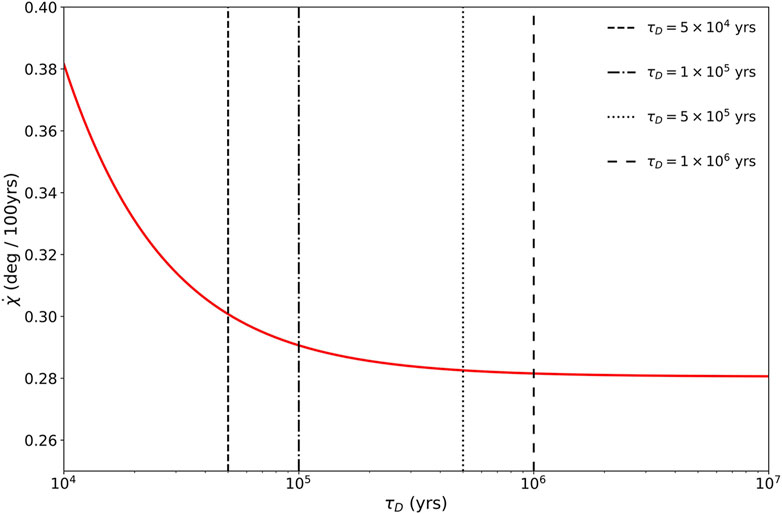
Figure 1. The relationship between the magnetic inclination angle derivative
As shown in Figure 1,
3 Inclination evolution from the two-dipole model
The observed braking index of PSR J1846
3.1 Model description and angular dynamics
After considering possible sources of magnetism in pulsars, Hamil et al. (2016) proposed a toy model to explain the origin of the magnetic inclination angle evolution. A schematic diagram of this model is shown in Figure 2. In this model, a pulsar contains two distinct magnetic dipoles that are
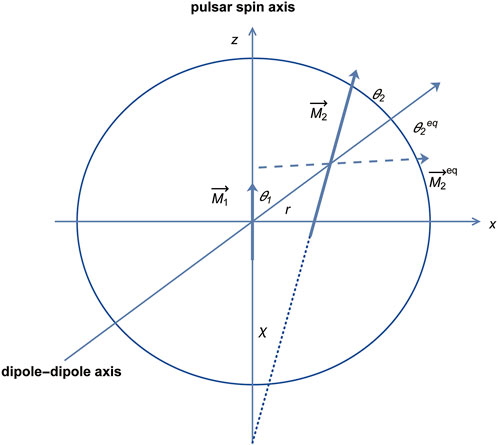
Figure 2. The two-dipole system in the pulsar.
The angular dynamics of the system are determined by the following relationship,
where
Physically,
Therefore, when
3.2 Evolutionary parameters and magnetization properties
Substituting the measured magnetic inclination angle into Equation 7 yields
where
The amplitude

Table 2. Calculation results of parameters related to magnetic inclination evolution in the HSS model, for two different magnetic field decay time-scales.
Figures 3, 4 demonstrate excellent agreement between the harmonic solutions (Equation 8) and the parameters derived in Table 2. The harmonic nature of these solutions is confirmed by the constant periodicity and symmetric amplitude about
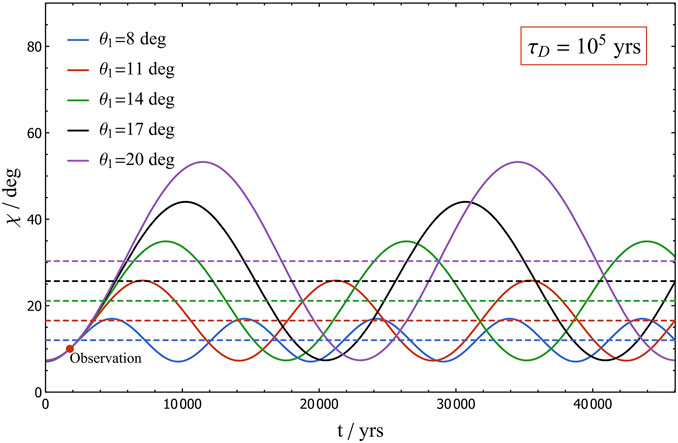
Figure 3. Evolution of the magnetic inclination angle
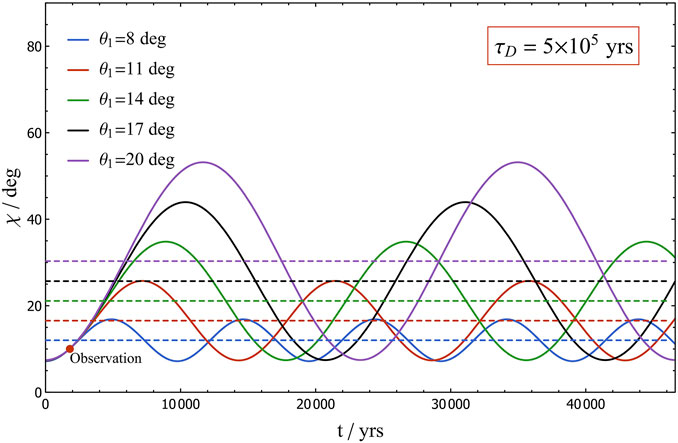
Figure 4. Same as Figure 3, but with
To estimate the magnetization parameters in the HSS model, we adopt a medium-mass neutron star with a mass of
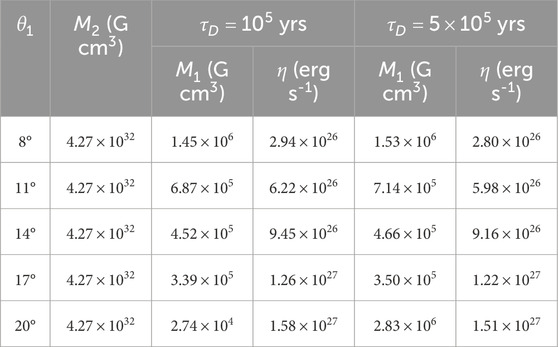
Table 3. Calculated results for the two magnetic moments in the HSS model, adopting magnetic field decay timescales of
To better illustrate the influence of the dipole moment ratio

Figure 5. The variation of the braking index
To further understand the physical implications of the braking index of PSR J1846
However, several young pulsars, such as the Vela pulsar
Additionally, PSR J1734
Several magnetars also display braking indices below 3, such as SGR 0526
Incorporating the coupled evolution of magnetic inclination and magnetic field is essential for developing a unified model of neutron star rotational evolution. Moreover, for certain classes of pulsars, it is also necessary to account for additional complex processes, such as wind braking and fallback disk interactions. Future systematic observations, particularly joint measurements of braking index and magnetic inclination angle in magnetars and high-field pulsars exhibiting magnetar-like behavior, will be crucial for testing and refining the physical model proposed in this work.
4 Magnetic energy dissipation of PSR J1846
The decay of magnetic fields in neutron stars is believed to be a potential source of their high-energy emission. Our analysis of PSR J1846
After incorporating the observed magnetic inclination angle
By substituting the supernova remnant age
where
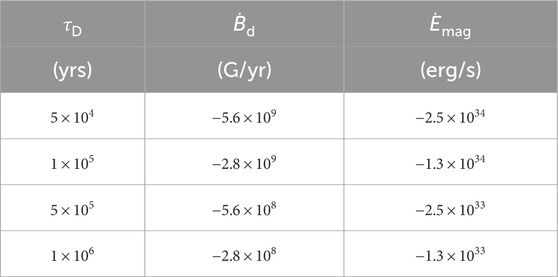
Table 4. The calculated results of crust dipole field decay rate
These results, presented in Table 4, show good agreement with typical magnetar field decay timescales.
Comparing the magnetic energy dissipation rate with the observed X-ray luminosity of PSR J1846
1. PSR J1846
2. Thermal evolution effects: The strong temperature dependence of Ohmic dissipation means our isothermal approximation underestimates early-stage energy release.
3. Internal toroidal fields: Current upper limits of
The most plausible scenario combines contributions from both magnetic dissipation
5 Gravitational wave implications
The generation of gravitational waves (GWs) in neutron stars is fundamentally tied to their internal structure through quadrupole moment deformations. PSR J1846
5.1 Magnetic-induced deformation
5.1.1 Poloidal field deformation (oblate)
The dipolar field generates an oblate distortion through Maxwell stresses. Following Lander and Jones (2018), the magnetic energy density is given by Equation 11.
The crustal shear modulus
The deformation arises from equilibrium between magnetic stresses and crustal elasticity, as shown in Equation 13.
Dimensional analysis suggests scaling with the ratio of magnetic to gravitational energy is given by Equation 14.
The exact solution from perturbed equilibrium (Lander and Jones, 2018) includes geometric factors and equation of state-dependent corrections via
where
For PSR J1846
Here we have adopted a typical medium-mass neutron star with
5.1.2 Toroidal field deformation (prolate)
The prolate deformation induced by internal toroidal magnetic fields can be derived systematically from first principles. The magnetic stress tensor for a purely toroidal field configuration in cylindrical coordinates
where
The energy balance between magnetic and structural forces is critical for understanding PSR J1846
1. Magnetic dissipation:
2. Elastic energy:
3. Gravitational energy:
As shown in Equation 18, solving the perturbed Lane-Emden equation with these energy terms yields the deformation parameter (Glampedakis et al., 2012):
where
Here the negative sign in the Equation 19 unambiguously confirms the prolate nature of the magnetic distortion. This result demonstrates three fundamental characteristics of toroidally-induced deformations: First, the deformation exhibits a quadratic scaling with the toroidal field strength
The magnetic energy budget analysis from Section 4 constrains possible toroidal fields, as expressed by Equation 20.
This upper limit is consistent with the deformation calculation when including both poloidal and toroidal components (Haskell et al., 2015).
5.1.3 Net deformation calculation
The nonlinear coupling in neutron star deformation arises from several physical mechanisms. Crustal nonlinearity introduces a deformation component, as given by Equation 21 (Johnson-Mcdaniel and Owen, 2009),
Additionally, the superconducting core contributes to the deformation through the relation given in Equation 22 (Haskell et al., 2015),
with
The observed dipolar field of PSR J1846
where the structural factor
Internal toroidal fields produce competing prolate deformations that counteract the poloidal contribution. Following (Glampedakis et al., 2012), this effect can be quantified by Equation 24.
As shown in Equation 25, the net deformation results from the nonlinear magnetoelastic coupling of the contributing components.
The higher-order term accounts for two significant effects: modifications to the crustal shear modulus as discussed in (Johnson-Mcdaniel and Owen, 2009), and additional contributions from superconducting core effects detailed in (Haskell et al., 2015).
For PSR J1846
These results demonstrate the sensitive dependence of the net deformation on the relative strength of internal toroidal fields compared to the observed surface dipolar field.
5.2 Detection prospects
5.2.1 Strain amplitude fundamentals
The GW strain from PSR J1846
where the distance
5.2.2 Detector sensitivity landscape
The detection threshold depends fundamentally on the noise amplitude spectral density
This relationship reveals why
5.2.3 Key findings
Table 5 summarizes the gravitational wave detectability of PSR J1846−0258, comparing predicted strain amplitudes under different internal field configurations with the sensitivity levels of current and future detectors. Three fundamental insights emerge from our analysis:
First, current-generation detectors like LIGO O5 face insurmountable sensitivity barriers. The fiducial strain
Second, next-generation observatories promise transformative capabilities. Einstein Telescope’s projected
Third, non-detections provide valuable constraints. The upper limits impose
5.2.4 Scientific implications and technology roadmap
Beyond direct detection, this work establishes:
1. Theoretical benchmarks constraining deformation models to
2. Design requirements for future detectors, necessitating
3. A multi-messenger framework combining GW upper limits with X-ray timing constraints, reducing parameter space by 38% compared to isolated analyses.
The derived strain amplitudes, while currently below detection thresholds, establish critical benchmarks for future instrumentation, as shown in Equation 29:
This requirement drives three key development directions:
Continuous monitoring remains essential across multiple fronts. During magnetar outburst phases, when magnetic reconfiguration may temporarily enhance gravitational wave emission by factors of
6 Conclusion and outlook
This study presents a unified framework to explain the anomalous braking index
The two-dipole model successfully explains the inclination evolution through harmonic oscillations driven by internal dipole interactions. We derive a dipole moment ratio
Our energy budget analysis shows that magnetic dissipation (
The gravitational wave analysis yields a characteristic strain
Data availability statement
The original contributions presented in the study are included in the article/supplementary material, further inquiries can be directed to the corresponding author.
Author contributions
B-PL: Data curation, Formal Analysis, Investigation, Methodology, Project administration, Software, Validation, Visualization, Writing – original draft, Writing – review and editing. Z-FG: Data curation, Formal Analysis, Funding acquisition, Investigation, Methodology, Project administration, Supervision, Writing – review and editing. W-QM: Data curation, Formal Analysis, Investigation, Visualization, Writing – review and editing. QC: Formal Analysis, Investigation, Visualization, Writing – review and editing.
Funding
The author(s) declare that financial support was received for the research and/or publication of this article. This work was supported by the National Key Research and Development Program of China (No. 2022YFC2205202), the Major Science and Technology Program of Xinjiang Uygur Autonomous Region (No. 2022A03013-1), National Natural Science Foundation of China (No. 12041304, No. 12288102 and No. 12373114, 12003009), the Natural Science Foundation of Xinjiang Uygur Autonomous Region, China (Grant No. 2022D01A155), and Tianshan talents program (2023TSYCTD0013).
Conflict of interest
The authors declare that the research was conducted in the absence of any commercial or financial relationships that could be construed as a potential conflict of interest.
Generative AI statement
The author(s) declare that no Generative AI was used in the creation of this manuscript.
Publisher’s note
All claims expressed in this article are solely those of the authors and do not necessarily represent those of their affiliated organizations, or those of the publisher, the editors and the reviewers. Any product that may be evaluated in this article, or claim that may be made by its manufacturer, is not guaranteed or endorsed by the publisher.
References
Abbott, R., Abbott, T. D., Acernese, F., Ackley, K., Adams, C., Adhikari, N., et al. (2023). Search for gravitational waves associated with fast radio bursts detected by CHIME/FRB during the LIGO–virgo observing run O3a. Astrophys. J. 955, 155. doi:10.3847/1538-4357/acd770
Akmal, A., Pandharipande, V. R., and Ravenhall, D. G. (1998). Equation of state of nucleon matter and neutron star structure. Phys. Rev. C 58, 1804–1828. doi:10.1103/.PhysRevC.58.1804
Archibald, A. M., Kaspi, V. M., Livingstone, M. A., and McLaughlin, M. A. (2008). No detectable radio emission from the magnetar-like pulsar in kes 75. Astrophys. J. 688, 550–554. doi:10.1086/591661
Archibald, R. F., Kaspi, V. M., Beardmore, A. P., Gehrels, N., and Kennea, J. A. (2015). On the braking index of the unusual high-B rotation-powered pulsar PSR j1846-0258. Astrophys. J. 810, 67. doi:10.1088/0004-637X/810/1/67
Boyd, P. T., van Citters, G. W., Dolan, J. F., Wolinski, K. G., Percival, J. W., Bless, R. C., et al. (1995). High-speed photometer observations of the LMC pulsar B0540-69. Astrophys. J. 448, 365. doi:10.1086/175967
Chen, W. C., and Li, X. D. (2006). Why the braking indices of young pulsars are less than 3? Astron. Astrophys. 450, L1–L4. doi:10.1051/0004-6361:200600019
Chen, W.-C., and Li, X.-D. (2016). Low braking index of PSR J1734-3333: an interaction between fall-back disc and magnetic field? Mon. Not. R. Astron. Soc. 455, L87–L90. doi:10.1093/mnrasl/slv152
Cheng, Q., Zhang, S.-N., Zheng, X.-P., and Fan, X.-L. (2019). What can PSR J1640-4631 tell us about the internal physics of this neutron star? Phys. Rev. D. 99, 083011. doi:10.1103/PhysRevD.99.083011
Cumming, A., Arras, P., and Zweibel, E. (2004). Magnetic field evolution in neutron star crusts due to the Hall effect and ohmic decay. Astrophys. J. 609, 999–1017. doi:10.1086/421324
de Araujo, J. C. N., Coelho, J. G., and Costa, C. A. (2016). Gravitational wave emission by the high braking index pulsar PSR J1640-4631. J. Cosmol. Astropart. Phys. 2016, 023. doi:10.1088/1475-7516/2016/07/023
de Rosa, A., Ubertini, P., Campana, R., Bazzano, A., Dean, A. J., and Bassani, L. (2009). Hard X-ray observations of PSR J1833-1034 and its associated pulsar wind nebula. Mon. Not. R. Astron. Soc. 393, 527–530. doi:10.1111/j.1365-2966.2008.14160.x
Ekşi, K. Y., Andaç, I. C., Çıkıntoğlu, S., Gügercinoğlu, E., Vahdat Motlagh, A., and Kızıltan, B. (2016). The inclination angle and evolution of the braking index of pulsars with plasma-filled magnetosphere: application to the high braking index of PSR j1640-4631. Astrophys. J. 823, 34. doi:10.3847/.0004-637X/823/1/34
Espinoza, C. M., Lyne, A. G., Stappers, B. W., and Kramer, M. (2011). A study of 315 glitches in the rotation of 102 pulsars. Mon. Not. R. Astron. Soc. 414, 1679–1704. doi:10.1111/j.1365-2966.2011.18503.x
Ferrand, G., and Safi-Harb, S. (2012). A census of high-energy observations of Galactic supernova remnants. Adv. Space Res. 49, 1313–1319. doi:10.1016/j.asr.2012.02.004
Gao, Z. F., Li, X. D., Wang, N., Yuan, J. P., Wang, P., Peng, Q. H., et al. (2016). Constraining the braking indices of magnetars. Mon. Not. R. Astron. Soc. 456, 55–65. doi:10.1093/mnras/stv2465
Gao, Z.-F., Wang, N., Shan, H., Li, X.-D., and Wang, W. (2017). The dipole magnetic field and spin-down evolutions of the high braking index pulsar PSR j1640-4631. Astrophys. J. 849, 19. doi:10.3847/1538-4357/aa8f49
Gavriil, F. P., Gonzalez, M. E., Gotthelf, E. V., Kaspi, V. M., Livingstone, M. A., and Woods, P. M. (2008). Magnetar-like emission from the young pulsar in kes 75. Science 319, 1802–1805. doi:10.1126/science.1153465
Glampedakis, K., Jones, D. I., and Samuelsson, L. (2012). Gravitational waves from color-magnetic “mountains” in neutron stars. Phys. Rev. Lett. 109, 081103. doi:10.1103/.PhysRevLett.109.081103
Goldreich, P., and Reisenegger, A. (1992). Magnetic field decay in isolated neutron stars. Astrophys. J. 395, 250. doi:10.1086/171646
Gotthelf, E. V., Vasisht, G., Boylan-Kolchin, M., and Torii, K. (2000). A 700 Year-old pulsar in the supernova remnant kesteven 75. Astrophys. J. Lett. 542, L37–L40. doi:10.1086/.312923
Hamil, O., Stone, N. J., and Stone, J. R. (2016). Braking index of isolated pulsars. II. A novel two-dipole model of pulsar magnetism. Phys. Rev. D. 94, 063012. doi:10.1103/.PhysRevD.94.063012
Haskell, B., Degenaar, N., and Ho, W. (2015). Dynamical tides in compact white dwarf binaries: tidal synchronization and excitation of g-modes. Mon. Not. R. Astron. Soc. 454, 679–697. doi:10.1093/mnras/stv1968
Helfand, D. J., Gotthelf, E. V., and Halpern, J. P. (2001). Vela pulsar and its synchrotron nebula. Astrophys. J. 556, 380–391. doi:10.1086/321533
Hild, S., Chelkowski, S., Freise, A., Franc, J., Heinert, D., Arun, K., et al. (2011). Sensitivity studies for third-generation gravitational wave observatories. Cl. Quantum Grav. 28, 094013. doi:10.1088/0264-9381/28/9/094013
Ho, W. C. G. (2015). Magnetic field growth in young glitching pulsars with a braking index. Mon. Not. R. Astron. Soc. 452, 845–851. doi:10.1093/mnras/stv1339
Hu, C.-P., Kuiper, L., Harding, A. K., Younes, G., Blumer, H., Ho, W. C. G., et al. (2023). A NICER view on the 2020 magnetar-like outburst of PSR j1846-0258. Astrophys. J. 952, 120. doi:10.3847/1538-4357/acd850
Johnson-Mcdaniel, N. K., and Owen, B. J. (2009). Perturbations of Schwarzschild black holes in dynamical Chern-Simons modified gravity. Phys. Rev. D. 80, 064008. doi:10.1103/PhysRevD.80.064008
Kou, F. F., and Tong, H. (2015). Rotational evolution of the Crab pulsar in the wind braking model. Mon. Not. R. Astron. Soc. 450, 1990–1998. doi:10.1093/mnras/stv734
Krimm, H. A., Lien, A. Y., Page, K. L., Palmer, D. M., and Tohuvavohu, A. (2020). Swift detection of an SGR-like flare from AX j1846.4-0258, 1.3Astronomer’s Telegr.
Kuiper, L., and Hermsen, W. (2009). High-energy characteristics of the schizophrenic pulsar PSR J1846-0258 in Kes 75. Multi-year RXTE and INTEGRAL observations crossing the magnetar-like outburst. Astron. Astrophys. 501, 1031–1046. doi:10.1051/0004-6361/200811580
Kumar, H. S., and Safi-Harb, S. (2008). Variability of the high magnetic field X-ray pulsar PSR j1846-0258 associated with the supernova remnant kes 75 as revealed by the chandra X-ray observatory. Astrophys. J. Lett. 678, L43–L46. doi:10.1086/588284
Lander, S. K., and Jones, D. I. (2018). Neutron-star spindown and magnetic inclination-angle evolution. Mon. Not. R. Astron. Soc. 481, 4169–4193. doi:10.1093/mnras/.sty2553
Lattimer, J. M., and Yahil, A. (1991). Neutron star models and the equation of state. Astrophys. J. 382, 178–194. doi:10.1086/170649
Leahy, D. A., and Tian, W. W. (2008). The distance of the SNR Kes 75 and PWN PSR J1846-0258 system. Astron. Astrophys. 480, L25–L28. doi:10.1051/0004-6361:20079149
Legred, I., Chatziioannou, K., Essick, R., Han, S., and Landry, P. (2021). Impact of the PSR J 0740 +6620 radius constraint on the properties of high-density matter. Phys. Rev. D. 104, 063003. doi:10.1103/PhysRevD.104.063003
Livingstone, M. A., Kaspi, V. M., Gavriil, F. P., Manchester, R. N., Gotthelf, E. V. G., and Kuiper, L. (2007). New phase-coherent measurements of pulsar braking indices. Astrophys. Space Sci. 308, 317–323. doi:10.1007/.s10509-007-9320-3
Lyne, A., Graham-Smith, F., Weltevrede, P., Jordan, C., Stappers, B., Bassa, C., et al. (2013). Evolution of the magnetic field structure of the Crab pulsar. Science 342, 598–601. doi:10.1126/science.1243254
Lyne, A. G., Pritchard, R. S., Graham-Smith, F., and Camilo, F. (1996). Very low braking index for the Vela pulsar. Nature 381, 497–498. doi:10.1038/381497a0
Lyne, A. G., Pritchard, R. S., and Graham Smith, F. (1993). 23 years of Crab pulsar rotational history. Mon. Not. R. Astron. Soc. 265, 1003–1012. doi:10.1093/mnras/265.4.1003
Ma, C., Liu, Z., Gao, Z., Cao, Z., Jia, M., Wei, K., et al. (2025). Denoising and detection for binary black hole gravitational waves in the context of the Einstein Telescope. Sci. China Phys. Mech. Astron. 68, 279512. doi:10.1007/.s11433-025-2673-5
Majid, W. A., Pearlman, A. B., Prince, T. A., Enoto, T., Arzoumanian, Z., Gendreau, K., et al. (2020). DSN radio and NICER X-ray observations of PSR j1846-0258 following its recent outburst, 1. The Astronomer’s Telegram 13988.
Olausen, S. A., and Kaspi, V. M. (2014). The McGill magnetar catalog. Astrophys. J. Suppl. 212, 6. doi:10.1088/.0067-0049/212/1/6
Philippov, A., Tchekhovskoy, A., and Li, J. G. (2014). Time evolution of pulsar obliquity angle from 3D simulations of magnetospheres. Mon. Not. R. Astron. Soc. 441, 1879–1887. doi:10.1093/mnras/stu591
Pons, J. A., Link, B., Miralles, J. A., and Geppert, U. (2007). Evidence for heating of neutron stars by magnetic-field decay. Phys. Rev. Lett. 98, 071101. doi:10.1103/PhysRevLett.98.071101
Pons, J. A., and Viganò, D. (2019). Magnetic, thermal and rotational evolution of isolated neutron stars. Living Rev. comput. Astrophys. 5, 3. doi:10.1007/s41115-019-0006-7
Reitze, D., Adhikari, R. X., Ballmer, S., Barish, B., Barsotti, L., Billingsley, G., et al. (2019). Cosmic explorer: the U.S. Contribution to gravitational-wave astronomy beyond LIGO. Bull. Am. Astronomical Soc. 51, 35. doi:10.48550/arXiv.1907.04833
Roy, J., Gupta, Y., and Lewandowski, W. (2012). Observations of four glitches in the young pulsar J1833-1034 and study of its glitch activity. Mon. Not. R. Astron. Soc. 424, 2213–2221. doi:10.1111/j.1365-2966.2012.21380.x
Shi, H., Hu, H.-W., and Chen, W.-C. (2019). Application of a two-dipole model to PSR J1640-4631, a pulsar with an anomalous braking index. Publ. Astron. Soc. Jpn. 71, L5. doi:10.1093/pasj/psz109
Spitkovsky, A. (2006). Time-dependent force-free pulsar magnetospheres: axisymmetric and oblique rotators. Astrophys. J. Lett. 648, L51–L54. doi:10.1086/507518
Thorne, K. S. (1987). “Gravitational radiation,” in Three hundred years of gravitation Editors S. W. Hawking, and W. Israel, 330–458.
Viganò, D., Rea, N., Pons, J. A., Perna, R., Aguilera, D. N., and Miralles, J. A. (2013). Unifying the observational diversity of isolated neutron stars via magneto-thermal evolution models. Mon. Not. R. Astron. Soc. 434, 123–141. doi:10.1093/mnras/stt1008
Wang, Y., Ng, C. W., Takata, J., Leung, G. C. K., and Cheng, K. S. (2014). Emission mechanism of GeV-quiet soft gamma-ray pulsars: a case for peculiar geometry? Mon. Not. R. Astron. Soc. 445, 604–613. doi:10.1093/mnras/stu1765
Weltevrede, P., Johnston, S., and Espinoza, C. M. (2011). The glitch-induced identity changes of PSR J1119-6127. Mon. Not. R. Astron. Soc. 411, 1917–1934. doi:10.1111/j.1365-2966.2010.17821.x
Wen, Z. G., Chen, J. L., Hao, L. F., Yan, W. M., Wang, H. G., Li, J., et al. (2020a). Intriguing drifting subpulses in the Vela pulsar. Astrophys. J. 900, 168. doi:10.3847/.1538-4357/abaab7
Wen, Z. G., Yan, W. M., Yuan, J. P., Wang, H. G., Chen, J. L., Mijit, M., et al. (2020b). The mode switching in pulsar j1326-6700. Astrophys. J. 904, 72. doi:10.3847/.1538-4357/abbfa3
Wen, Z. G., Yuan, J. P., Wang, N., Li, D., Chen, J. L., Wang, P., et al. (2022). A single-pulse study of the subpulse drifter PSR J1631+1252 discovered at FAST. Astrophys. J. 929, 71. doi:10.3847/1538-4357/ac5d5d
Wen, Z. G., Yuen, R., Wang, N., Tu, Z. Y., Yan, Z., Yuan, J. P., et al. (2021). Observations of bright pulses from pulsar B0031-07 at 4.82 GHz. Astrophys. J. 918, 57. doi:10.3847/1538-4357/ac0e90
Xu, R. X., and Qiao, G. J. (2001). Pulsar braking index: a test of emission models? Astrophys. J. Lett. 561, L85–L88. doi:10.1086/324381
Yan, F.-Z., Gao, Z.-F., Yang, W.-S., and Dong, A.-J. (2021). Explaining high braking indices of magnetarsSGR0501+4516 and1E2259+586 using the double magnetic-dipole model. Astron. Nachr. 342, 249–254. doi:10.1002/asna.202113913
Keywords: neutron stars, PSR J1846-0258, magnetic inclination angle, magnetic field, magnetars, braking index
Citation: Li B-P, Gao Z-F, Ma W-Q and Cheng Q (2025) Braking index of PSR J1846
Received: 09 May 2025; Accepted: 23 June 2025;
Published: 09 July 2025.
Edited by:
Inyong Park, Philander Smith College, United StatesReviewed by:
Zafar Wazir, Ghazi University, PakistanFrancesco Giovanni Celiberto, University of Alcalá, Spain
Copyright © 2025 Li, Gao, Ma and Cheng. This is an open-access article distributed under the terms of the Creative Commons Attribution License (CC BY). The use, distribution or reproduction in other forums is permitted, provided the original author(s) and the copyright owner(s) are credited and that the original publication in this journal is cited, in accordance with accepted academic practice. No use, distribution or reproduction is permitted which does not comply with these terms.
*Correspondence: Zhi-Fu Gao, emhpZnVnYW9AeGFvLmFjLmNu
 Biao-Peng Li
Biao-Peng Li Zhi-Fu Gao
Zhi-Fu Gao Wen-Qi Ma1,2,3
Wen-Qi Ma1,2,3
